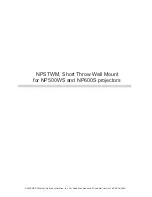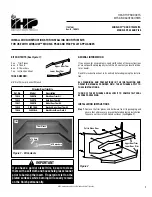
12
english
3
Construction and function (continued)
There are predefined profiles for configuring the sensor for
common applications. These profiles are used to configure
thresholds for the vibration velocity, zone limits and other
parameters of the vibration module (i. e. time window,
band limits) to predefined values.
– ISO 10816-3 group 1, rigid
– ISO 10816-3 group 1, flexible
– ISO 10816-3 group 2, rigid
– ISO 10816-3 group 2, flexible
– Sequential machine, normal
– Sequential machine, fast
– Sequential machine, very fast
– User-defined profile
The exact configuration of the sensor,
depending on the selected profile, is explained
in Section
Application choice (APPLICATION
Rotary machines (ISO 10816-3)
Machines in group 1
include machines with a rated
power above 300 kW or electrical machines with an axis
height of H ≥ 315 mm. These machines generally have
slide bearings and an operating speed range from 120 rpm
to 15,000 rpm.
Machines in group 2
include machines with a rated
power between 15 kW and 300 kW or electrical machines
with an axis height of 160 mm ≤ H < 315 mm. These
machines generally have rolling bearings and the operated
speed lies above 600 rpm.
Within a machine group, a distinction is also made
between rigid and flexible substructures. If the
eigenfrequency of the complete system is above 25% of
the most important excitation frequency in the direction of
the measurement, it is a rigid substructure.
Sequential machines
For machines that operate sequentially (e. g. presses,
pneumatic processes, robots (robot arms) and linear
drives), there are three ready-made profiles. These differ
with respect to the machine speed. In this context, there is
a subdivision into moderate, fast and very fast process
speeds.
User-defined profile
In addition to the predefined profiles, there is also a user-
defined profile. Here, it is possible to freely adapt the
parameters to the process to be monitored.
Use of the user-defined profile requires an
in-depth process understanding and, in the
event of an incorrect configuration, can result in
the output data not being able to permit an
assessment of the system status.
Vibration acceleration
The following values for all three axes as well as the
magnitude are determined by the vibration acceleration
signal:
– RMS value
– Peak-to-peak value
The calculation and evaluation take place within the
configured vibration module time window.
In addition, the sensor can detect when a pre-alarm and
main-alarm thresholds are exceeded. Here, a hold time
can be specified for how long the threshold must be
exceeded to trigger an alarm (see Fig. 3-7).
t
a-RMS
a
a
a
a
Current
vibration value
Main alarm
threshold
Pre-alarm
threshold
I
II III
IV
VI
V
a
EVENT RESPONSE DELAY
I
Pre-alarm threshold exceeded
II
Pre-alarm triggered
III
Pre-alarm threshold underrun (pre-alarm remains active,
because the duration of the underrun is too short)
IV
Main alarm threshold exceeded (main-alarm remains
deactived, because the duration of the exccedance is too
short)
V
Main alarm threshold exceeded
VI
Main alarm triggered
Fig. 3-7: Vibration acceleration – Pre-alarm and main-alarm
thresholds
BCM R15E-00 _ -DI00-_ _ , _-S4
Condition Monitoring Sensor
Summary of Contents for BCM R15E-00 Series
Page 1: ...BCM R15E 00_ DI00 _ _ _ S4 deutsch Betriebsanleitung english User s guide...
Page 2: ...www balluff com...
Page 3: ...BCM R15E 00_ DI00 _ _ _ S4 Betriebsanleitung deutsch...
Page 4: ...www balluff com...
Page 49: ...BCM R15E 00_ DI00 _ _ _ S4 User s Guide english...
Page 50: ...www balluff com...
Page 95: ......
















































